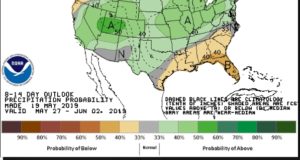Planting Conditions Report, May 20, 2019 – Soil Moisture Status
go.ncsu.edu/readext?603461
en Español / em Português
El inglés es el idioma de control de esta página. En la medida en que haya algún conflicto entre la traducción al inglés y la traducción, el inglés prevalece.
Al hacer clic en el enlace de traducción se activa un servicio de traducción gratuito para convertir la página al español. Al igual que con cualquier traducción por Internet, la conversión no es sensible al contexto y puede que no traduzca el texto en su significado original. NC State Extension no garantiza la exactitud del texto traducido. Por favor, tenga en cuenta que algunas aplicaciones y/o servicios pueden no funcionar como se espera cuando se traducen.
Português
Inglês é o idioma de controle desta página. Na medida que haja algum conflito entre o texto original em Inglês e a tradução, o Inglês prevalece.
Ao clicar no link de tradução, um serviço gratuito de tradução será ativado para converter a página para o Português. Como em qualquer tradução pela internet, a conversão não é sensivel ao contexto e pode não ocorrer a tradução para o significado orginal. O serviço de Extensão da Carolina do Norte (NC State Extension) não garante a exatidão do texto traduzido. Por favor, observe que algumas funções ou serviços podem não funcionar como esperado após a tradução.
English
English is the controlling language of this page. To the extent there is any conflict between the English text and the translation, English controls.
Clicking on the translation link activates a free translation service to convert the page to Spanish. As with any Internet translation, the conversion is not context-sensitive and may not translate the text to its original meaning. NC State Extension does not guarantee the accuracy of the translated text. Please note that some applications and/or services may not function as expected when translated.
Collapse ▲Keith Edmisten, Professor of Crop Science & Soil Sciences and Extension Cotton Specialist
Guy Collins, Extension Associate Professor – Cotton
It appears that we are past having to worry about temperatures for planting so we will not post anymore temperature based planting conditions predictions unless there are some dramatic changes. We are now concerned about the rapidly decreasing soil moisture over most of our cotton producing areas. The forecast for Rocky Mount is for 0-20% chance of precipitation until it finally rises to 40% on May 30.
This is very concerning in areas that have not finished planting or are in need of replanting before the first crop insurance deadline, which is Saturday. Some growers will have tough decisions about how to deal with the later part of the cotton planting window. Here are some options to consider:
- Some growers may be able to plant deeper to “plant into moisture”. This can be risky with cotton, especially where soils crust. It is generally not a good idea to plant more than 1 inch deep to get into moisture. Hill-dropping is probably more important than normal if you plan to plant deeper than 1/2 inch in an effort to get the seed into moisture. Use the best quality and largest seed you can find if you want to try to plant deeper than 1/2 inch. This is especially import because the average seed quality is lower than normal this year. A very few small areas received some rain this weekend that may be sufficient for planting….in most other cases however, no-till fields with heavy cover may be the only places with sufficient soil moisture for planting and emergence (evaluate this on a case by case basis). Given the high temperatures over the weekend, several fields may have enough moisture to sprout seed if planting deep, but not enough for seedlings to emerge. If this is the case, or if you have soils that are crust-prone (typically lighter colored Coastal Plains soils), you are probably better of to “dust it in” (plant shallow) and let a rain bring it up. You may want to get that crust-buster out of the weeds and have it ready!
- If you are dusting seed in, consider that your effective planting date is whenever you get rain to bring it up. It is probably a good idea to use early maturing varieties when dusting in cotton at this point, as anything dusted in may end up needing to be treated as late planted cotton.
Below is the 8-14 day outlook for precipitation that covers May 27 to June 2. During this period it looks like we may shift from being dryer than normal to closer to normal.



